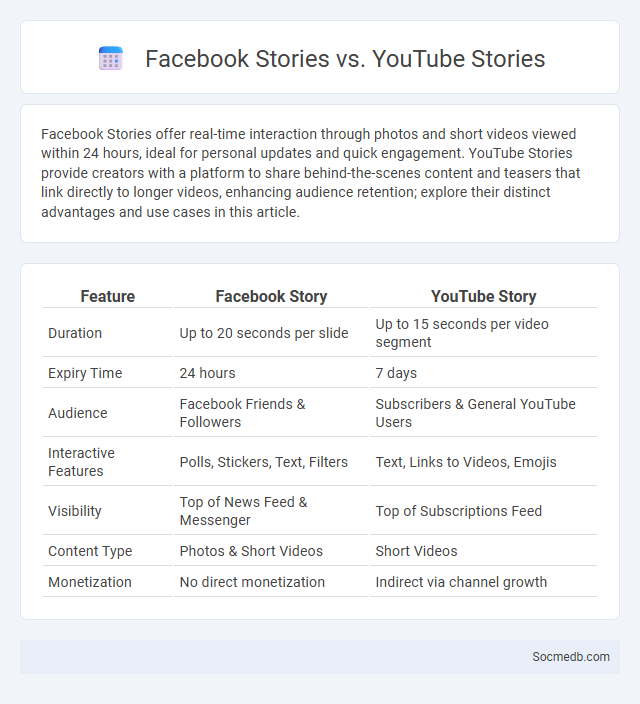
Photo illustration: Facebook Story vs YouTube Story
Facebook Stories offer real-time interaction through photos and short videos viewed within 24 hours, ideal for personal updates and quick engagement. YouTube Stories provide creators with a platform to share behind-the-scenes content and teasers that link directly to longer videos, enhancing audience retention; explore their distinct advantages and use cases in this article.
Table of Comparison
| Feature | Facebook Story | YouTube Story |
|---|---|---|
| Duration | Up to 20 seconds per slide | Up to 15 seconds per video segment |
| Expiry Time | 24 hours | 7 days |
| Audience | Facebook Friends & Followers | Subscribers & General YouTube Users |
| Interactive Features | Polls, Stickers, Text, Filters | Text, Links to Videos, Emojis |
| Visibility | Top of News Feed & Messenger | Top of Subscriptions Feed |
| Content Type | Photos & Short Videos | Short Videos |
| Monetization | No direct monetization | Indirect via channel growth |
Introduction to Social Media Stories
Social media stories are short, engaging content formats designed to disappear after 24 hours, creating a sense of urgency for viewers. These stories can include photos, videos, text, and interactive elements like polls or stickers, making them a versatile tool for real-time communication. By leveraging social media stories, you can boost audience engagement and share authentic moments instantly.
What is a Facebook Story?
A Facebook Story is a temporary post consisting of photos, videos, or text that disappears after 24 hours, designed to share moments in a more casual, engaging format. It allows users to add filters, stickers, and interactive elements, enhancing viewers' experience and boosting engagement. Stories appear at the top of the Facebook app, encouraging real-time connections and spontaneous sharing.
What is a YouTube Story?
A YouTube Story is a short, vertical video feature designed to engage viewers with ephemeral content that disappears after seven days. It allows creators to share behind-the-scenes moments, updates, or promotions, enhancing your channel's interaction and visibility. This feature is especially effective for building a personal connection with your audience and increasing real-time engagement.
What is a Standard Story Format?
A standard story format on social media typically involves a vertical, full-screen visual that lasts up to 15 seconds, designed for temporary sharing and immediate engagement. This format supports a combination of images, videos, text, stickers, and interactive elements like polls or questions to enhance user interaction. Platforms such as Instagram, Snapchat, and Facebook utilize this ephemeral format to create a sense of urgency and authenticity, driving higher user retention and real-time communication.
Key Differences Between Facebook Story and YouTube Story
Facebook Stories disappear after 24 hours, offering short-lived, casual content primarily designed for personal updates and real-time engagement within your network. YouTube Stories, available only to creators with over 10,000 subscribers, enable video content with a 15-second limit that targets broader public discovery and subscriber interaction. Understanding these platform-specific formats helps you tailor content effectively to boost visibility and audience engagement.
Audience Engagement: Facebook vs YouTube Stories
Facebook stories offer interactive features such as polls, questions, and reactions that boost audience engagement by facilitating real-time communication and feedback. YouTube Stories leverage video content with clickable links and tags, attracting viewers who prefer dynamic and visual storytelling. Understanding your audience's preference between these platforms can significantly enhance your engagement strategy and content reach.
Story Features and Functionality Comparison
Social media platforms offer diverse story features including Snapchat's ephemeral 24-hour content, Instagram's interactive stickers and polls, and Facebook's cross-platform story sharing. These functionalities enable You to engage audiences with real-time updates, multimedia integration, and direct feedback through reactions and replies. Comparing platforms reveals variations in story duration, editing tools, and audience reach tailored to personal or business communication needs.
Content Creation and Editing Tools
Content creation and editing tools on social media platforms empower you to produce engaging visuals, videos, and written posts that capture your audience's attention. Advanced features like AI-driven filters, real-time collaboration, and intuitive editing interfaces streamline the creative process. Leveraging these tools enhances your brand presence and drives higher engagement rates across diverse social networks.
Best Practices for Using Stories on Each Platform
Maximize engagement by tailoring your stories to each social media platform's unique features and audience preferences. Use Instagram Stories for interactive polls and behind-the-scenes content, Snapchat for real-time updates with fun filters, and Facebook Stories to reach a broader demographic with shareable highlights. Your consistent use of platform-specific best practices ensures your stories captivate viewers and boost meaningful connections.
Choosing the Right Story Platform for Your Brand
Selecting the optimal social media story platform depends on understanding your brand's target audience demographics and content style. Instagram Stories excel for visually-driven, lifestyle-oriented brands targeting younger users, while LinkedIn Stories suit B2B companies focusing on professional engagement. Analyze platform features such as interactivity, reach, and analytics tools to maximize brand visibility and engagement effectively.
 socmedb.com
socmedb.com